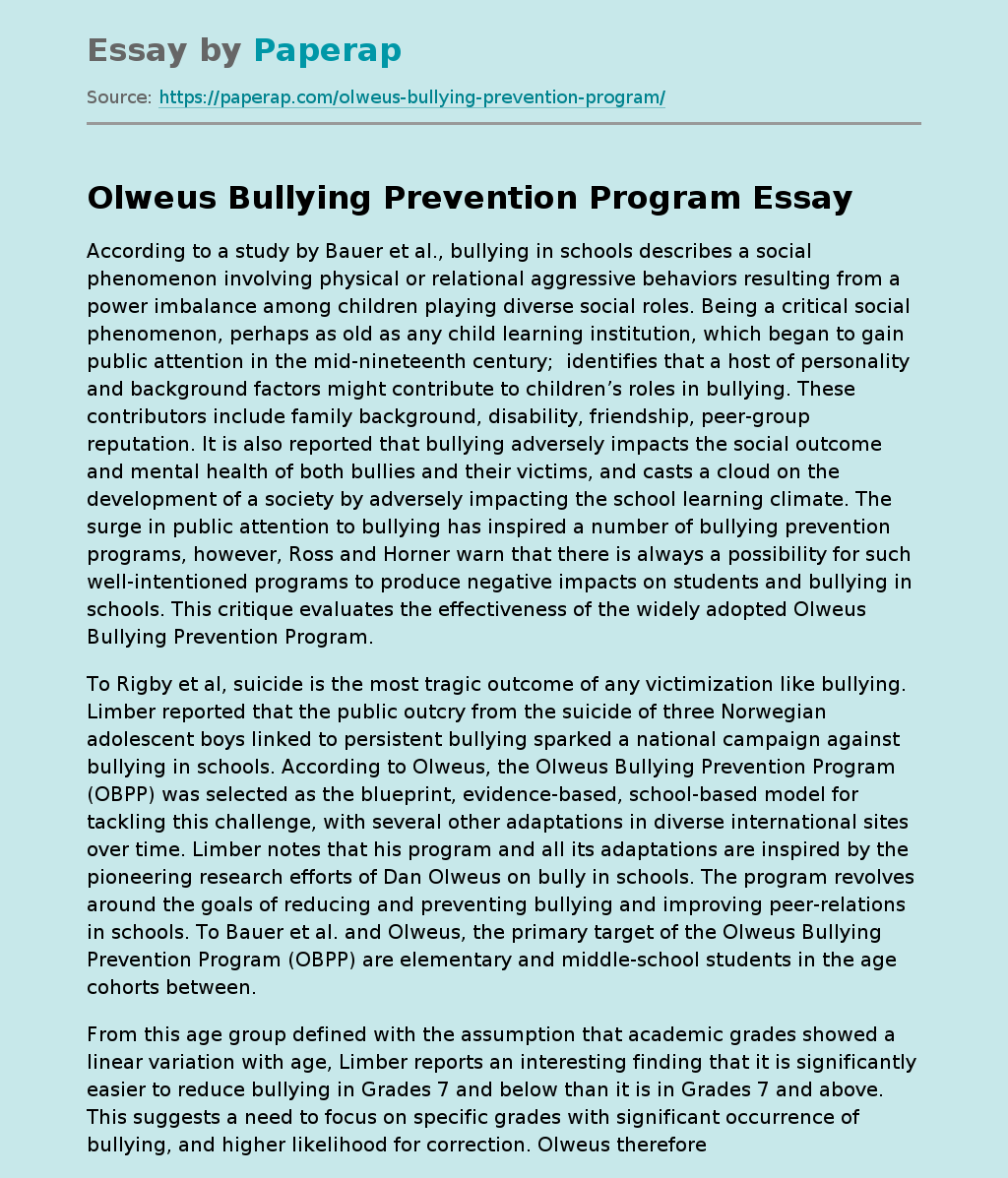Olweus Bullying Prevention Program
According to a study by Bauer et al., bullying in schools describes a social phenomenon involving physical or relational aggressive behaviors resulting from a power imbalance among children playing diverse social roles. Being a critical social phenomenon, perhaps as old as any child learning institution, which began to gain public attention in the mid-nineteenth century; identifies that a host of personality and background factors might contribute to children’s roles in bullying. These contributors include family background, disability, friendship, peer-group reputation.
It is also reported that bullying adversely impacts the social outcome and mental health of both bullies and their victims, and casts a cloud on the development of a society by adversely impacting the school learning climate. The surge in public attention to bullying has inspired a number of bullying prevention programs, however, Ross and Horner warn that there is always a possibility for such well-intentioned programs to produce negative impacts on students and bullying in schools. This critique evaluates the effectiveness of the widely adopted Olweus Bullying Prevention Program.
To Rigby et al, suicide is the most tragic outcome of any victimization like bullying. Limber reported that the public outcry from the suicide of three Norwegian adolescent boys linked to persistent bullying sparked a national campaign against bullying in schools. According to Olweus, the Olweus Bullying Prevention Program (OBPP) was selected as the blueprint, evidence-based, school-based model for tackling this challenge, with several other adaptations in diverse international sites over time. Limber notes that his program and all its adaptations are inspired by the pioneering research efforts of Dan Olweus on bully in schools.
The program revolves around the goals of reducing and preventing bullying and improving peer-relations in schools. To Bauer et al. and Olweus, the primary target of the Olweus Bullying Prevention Program (OBPP) are elementary and middle-school students in the age cohorts between.
From this age group defined with the assumption that academic grades showed a linear variation with age, Limber reports an interesting finding that it is significantly easier to reduce bullying in Grades 7 and below than it is in Grades 7 and above. This suggests a need to focus on specific grades with significant occurrence of bullying, and higher likelihood for correction. Olweus therefore hinted that students in Grade 5 and Grade 7 were commonly given special attention in this program. For an evaluation of the Olweus Bullying Prevention Program (OBPP), some of its strengths can be immediately highlighted in its structure. Limber defined the components in the implementation of the program to include: “school-wide”, “classroom-level”, “individual-level” and “community-level” activities. In particular, Bauer et al. note that the community-level component of the Olweus Bullying Prevention Program engages in proactively raising awareness within the local communities concerning the danger and best practices for tackling bullying.
This would ensure that factors, like family background and disability connected with bullying that are beyond the grasp of the school environment as Rigby et al described, are managed effectively in the local communities. As an addition, within schools its emphasis on improving peer relations by classroom-level conflict resolution training is an important strength of the program. Another fundamental strength of the program is its insistence on stating firm rules on student behavior, and the consistent use of non-punitive, non-physical non-hostile dissuasion against violating such rules. This leverages on the development of evidence-based school-wide bullying prevention policies.
To contrast, these, Limber highlights the stiff time constraint on some teachers across sites as important weakness of the Olweus Bullying Prevention Program. Schools in the United States of America reported devoting less time to staff and classroom meetings required in the implementation of this program. Looking at its flaw in limiting bullying to repeated aggression, and the even less concrete definition of racism in the program, Bauer et al highlighted a weakness in defining bullying. This ensures that some aggressive acts go unmanaged. Another important weakness of the program is its sensitivity to the homogeneity of the student sample covered. Although the Olweus Bullying Prevention Program recorded a 50% reduction in bullying from its “First Bergen Project Against Bullying” in relatively ethnically homogeneous schools in Norway, the “Oslo Project Against Bullying” like several others in more heterogeneous environments in the United States of America produced significantly less reduction rates.
From the available evidence, there is a divergence on the effectiveness of the Olweus Bullying Prevention Program. Although Limber supports that the program systematically contributes to reducing bullying in both Norway and the United States of America, Bauer et al highlight that the program doesn’t produce any significant overall reduction in bullying, except on bullying mediated by gender and ethnicity. To derive greater benefits from the programs in the future, scheduling bullying prevention programs into the school curriculum is recommended, as well as cultural adaptation. Implementation should also be improved by improving teachers’ perception of bullying and staff importance in tackling bullying in classes. At school level, open communication and teacher-teacher collaboration is recommended.
Olweus Bullying Prevention Program. (2021, Dec 15). Retrieved from https://paperap.com/olweus-bullying-prevention-program/

